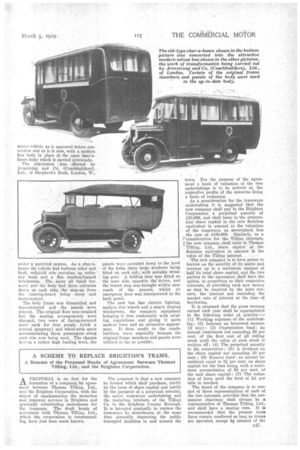PHASES OF• PASSENGER TRAVEL.
Page 66

Page 67

If you've noticed an error in this article please click here to report it so we can fix it.
Notes on Every Aspect of Coach and Bus Development.
ADESIRE on the part of the Prince of Wales to see first-hand many of the remarkably interesting methods and appliances which are employed for the maintenance of London's passenger road-transport vehicles, led to His Royal Highness paying a visit a few days ago to the extensive workshops of the London General Omnibus Co., Ltd., at Chiswick, whilst he also inspected the Underground overhaul works at .Acton.
The Prince spent about two hours in the works, and was much impressed by all that he saw. He was met by Lord Ashfield upon arrival at the Chiswick works, and included in the party which toured the -works with the Prince were Messrs. George J. Shave (chief engineer and operating manager of the L.G.O. Co.), A. Rosier (superintendent of rolling stock of the L.G.O. Co.), C. Leese (engineer-in-charge), and H. LansdoWn (traffic superintendent).
The Prince first passed through the ticket office, which is a commodious building in which millions of tickets are handled by a staff of 250 girls. He saw the ticket-boxes of conductors being speedily replenished as they passed along a moving conveyor, and was keenly interested in one of the checks that are used in the examination of conductors' returns.
A visit was next made to the museum, and here the Prince of Wales was shown two specimens of old horsed omnibuses. It is worth recalling that, at one period, 20,000 bus horses -were owned by the company. Amongst the men who greeted the Royal visitor
were many who had served on the old horsed buses, some of them being chainhorse boys who had charge of the extra horses that were held in readiness at the bottom of steep hills on certain bus routes. The Prince was also shown " Old Bill," the famous bus having an inseparable link with war days.
Then followed a tour around the Works proper, the start being made at the point where a bus comes in for overhaul after travelling about 40,000 miles. As he progressed through the works from one department,to another, between big avenues of engines and others of chassis, bodies and wheels, he
was able to witness in detail the stripping of each vehicle and its various phases of rebuilding until it is in a suitable condition once again to be placed in regular service. He was much impressed with the use made of moving conveyors, which considerably facilitate the work of overhaul.
An interesting demonstration was arranged in the paint shop, where the side of a bus was painted, not by means of a brush or spraying equiprnent, but by allowing the liquid to flow
down from the top from a nozzle(' can. It was pointed out to the Prince of Wales that only after much experimenting had it been found possible to adopt this procedure, which actually gives a thinner coat than is possible when adopting the spraying system. The paint that drips from the bottom edge of the panel is collected, filtered and used again. It is worthy of note that the painting of a panel in this manner occupies one minute, as compared with 25 minutes that would be taken in treating the same area by using a brush.
The Prince regarded with a smile the ' operations of cleaning the cushions of buses, as they passed through a machine in which they were beaten from every angle by hammers.
The "laundry." as it is humorously referred to, was also inspected by the Prince. This consists of a number of devices whereby the parts of the but that is being overhauled are subjected to a bath of steam and soda in order to remove all dirt. The final view which the Prince had of the factory was at a point where the completely overhauled bus arrives at the end of a conveyor and is automatically started up and driven away once again to play its part in meeting the travelling requirements of the London public. The complete operation of overhaul now takes three days, as compared with 10 to 20 a few years ago.
The visit was concluded by a short tour of the Underground overhaul works at Acton.. under a patented system. As a char-abanes the vehicle had bulbous sides and back, celluloid side curtains, an ordinary hood and a • flat wooden-framed windscreen. The seats all faced forward and the body had three entrance doors on each side, the step-up from the running-board being steep and inconvenient. •
The body frame was dismantled and reconstructed and the panels were altered. The original floor was retained but the seating arrangements were changed, two rows of facing-forward seats each for four people .(with a central gang-way) and wheel-archseats accommodating three passengers along each side now being used. The chassis havfng a rather high loading level, the
Piiaels were extended down to the level of the hubs, three large windows being fitted on each side, with suitable winding gear. A folding door was .fitted on the near side, opposite the driver, and the lowest step was brought within easy reach of the ground, whilst an emergency door was incorporated in the back panel.
The new bus has electric lighting, modern disc wheels and a smart, sloping windscreen, the complete equipment bringing it into conformity with existjug regulations and giving it quite modern lines and an attractive appearance. It does credit to the coachbuilders, more especially because the original frame members and panels were utilized so far as possible.












































































































